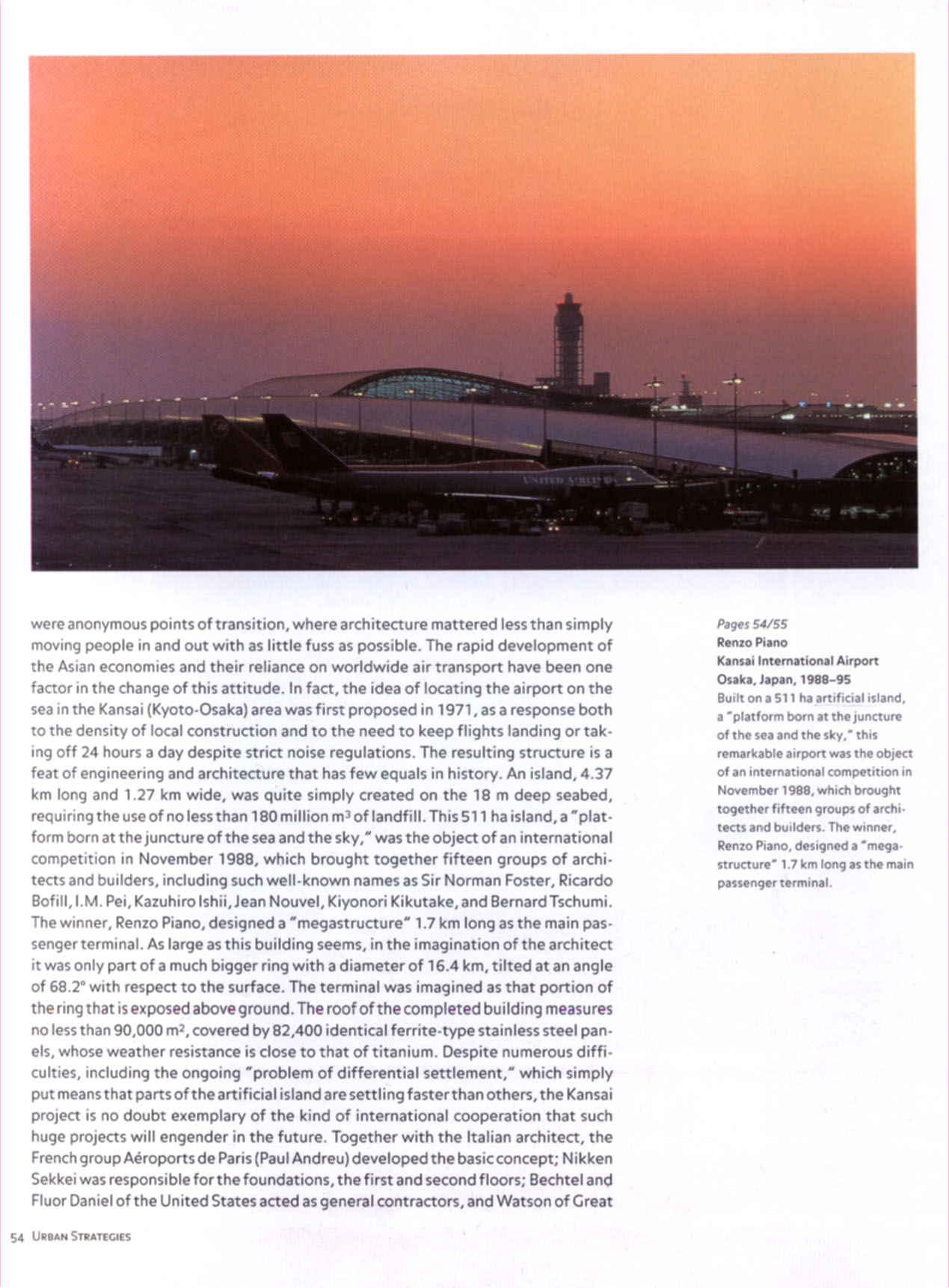New Forms Taschen 049


Pages54/SS Renzo Piano
Kansai International Airport Osaka. Japan, 1988-95
Built on a 511 ha artificial island, a 'platform born at the juncture of the sea and the sky,' this remarkable airport was the object of an international competition in November 1988, which brought together fifteen groups of archi-tects and builders. The winner, Renzo Piano, designed a "mega-structure' 1.7 km long as the main passenger terminal.
were anonymous points of transition, where architecture mattered less than simply moving people in and out with as little fuss as possible. The rapid development of the Asian economies and their reliance on worldwide air transport have been one factor in the change of this attitude. In fact, the idea of locating the airport on the sea in the Kansai (Kyoto-Osaka) area was first proposed in 1971, as a response both to the density of local construction and to the need to keep flights landing or tak-ing off 24 hours a day despite strict noise regulations. The resulting structure is a feat of engineering and architecture that has few equals in history. An island, 4.37 km long and 1.27 km wide, was quite simply created on the 18 m deep seabed, requiring the use of no less than 180 million m3 of landf ill. This 511 ha island, a 'platform born at the juncture of the sea and the sky,' was the object of an international competition in November 1988, which brought together fifteen groups of archi-tects and builders, including such well-known names as Sir Norman Foster, Ricardo Bofill, I.M. Pei, Kazuhiro Ishii, Jean Nouvel, Kiyonori Kikutake, and Bernard Tschumi. The winner, Renzo Piano, designed a 'megastructure' 1.7 km long as the main pas-senger terminal. As large as this building seems, in the imagination of the architect it was only part of a much bigger ring with a diameter of 16.4 km, tilted at an angle of 68.2° with respect to the surface. The terminal was imagined as that portion of the ring that is exposed above ground. The roof of the completed building measures no less than 90,000 m2, covered by 82,400 identical ferrite-type stainless Steel pan-els, whose weather resistance is close to that of titanium. Despite numerous diffi-culties, including the ongoing 'problem of differential settlement,' which simply put means that parts of the artif icial island are settling faster than others, the Kansai project is no doubt exemplary of the kind of international cooperation that such huge projects will engender in the futurę. Together with the Italian architect, the French group Aeroports de Paris (Paul Andreu) developed the basieconcept; Nikken Sekkei was responsible for the foundations, the first and second f loors; Bechtel and Fluor Daniel of the United States acted as generał contractors, and Watson of Creat
54 Urban Strategies
Wyszukiwarka
Podobne podstrony:
59793 New Forms Taschen 175 Ptgn 186/187 Shin Takamatsu Kirin Płaza Osaka. Japan, 1985-87 Locat
New Forms Taschen 091 Fumihiko Maki National Museum of Modern Art Kyoto. Japan, 1983-86 Fumihik
New Forms Taschen 131 Ptgti 140/141 Jean Nouvel Fondation Cartier Paris. France. 1991-94&n
New Forms Taschen 140 Page 151 Massimiliano Fuksas Entrance to Grotto Niaux, Franco. 1988-93&nb
New Forms Taschen 166 A finał, almost amusing example is that of Philippe Starck s, "La Flamme,
New Forms Taschen 097 I M . Pei Rock and Roli Hall of Famę Cleveland, Ohio, 1993-95 With its py
więcej podobnych podstron